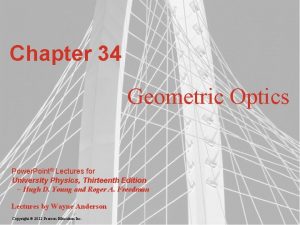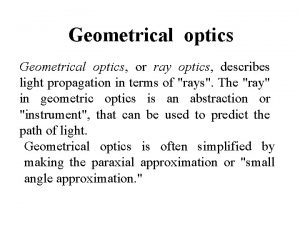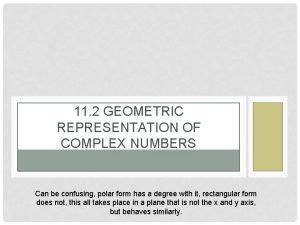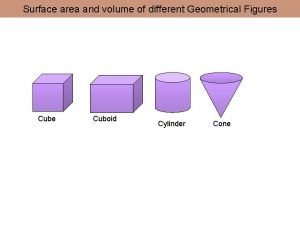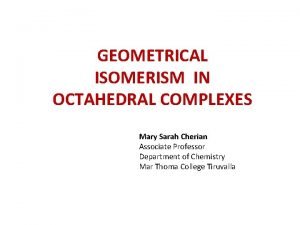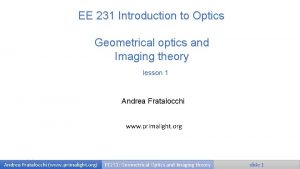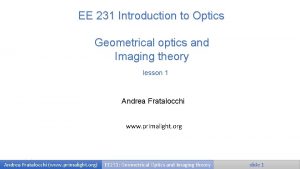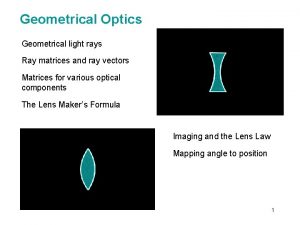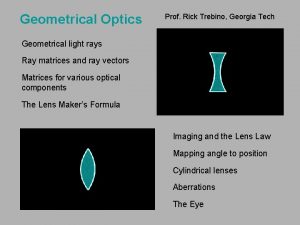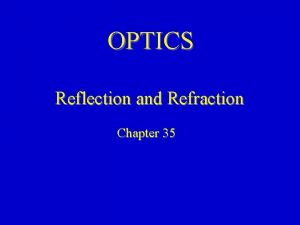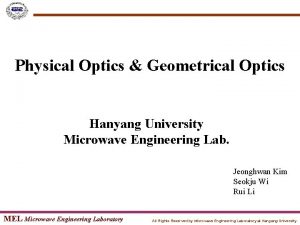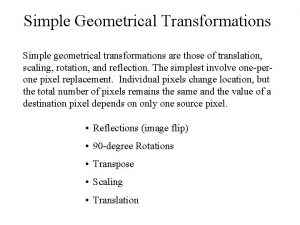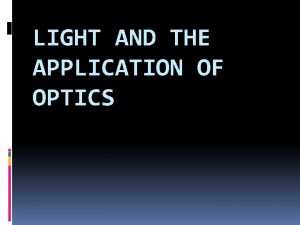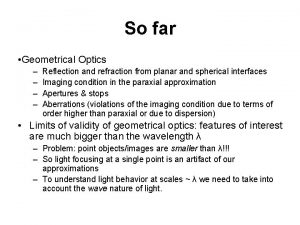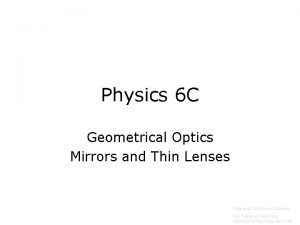EE 231 Introduction to Optics Geometrical optics and


























- Slides: 26

EE 231 Introduction to Optics Geometrical optics and Imaging theory lesson 2 Andrea Fratalocchi www. primalight. org 9/25/2020 Andrea Fratalocchi (www. primalight. org) EE 231: Geometrical Optics and Imaging theory slide 1 1

Matrix Optics is a powerful technique to trace rays in paraxial approximation. It is based on the fact that Snell law in paraxial approximation is linear: 9/25/2020 Andrea Fratalocchi (www. primalight. org) EE 231: Geometrical Optics and Imaging theory slide 2 2

Matrix Optics 9/25/2020 Andrea Fratalocchi (www. primalight. org) EE 231: Geometrical Optics and Imaging theory slide 3 3

9/25/2020 Andrea Fratalocchi (www. primalight. org) EE 231: Geometrical Optics and Imaging theory slide 4 4

9/25/2020 Andrea Fratalocchi (www. primalight. org) EE 231: Geometrical Optics and Imaging theory slide 5 5

9/25/2020 Andrea Fratalocchi (www. primalight. org) EE 231: Geometrical Optics and Imaging theory slide 6 6

Matrix Optics Lenses positive 9/25/2020 Andrea Fratalocchi (www. primalight. org) negative EE 231: Geometrical Optics and Imaging theory slide 7 7

Matrix Optics v Question 1: for a Plano-Convex lens, in a focusing application such as the one illustrated on the left, which side would you choose? 9/25/2020 Andrea Fratalocchi (www. primalight. org) EE 231: Geometrical Optics and Imaging theory slide 8 8

9/25/2020 Andrea Fratalocchi (www. primalight. org) EE 231: Geometrical Optics and Imaging theory slide 9 9

Matrix Optics Image Formation by thin Lenses Lens equation: 9/25/2020 Andrea Fratalocchi (www. primalight. org) EE 231: Geometrical Optics and Imaging theory slide 10 10

Matrix Optics q Homework 1: demonstrate by using the ABCD matrix the lens imaging equation Lens equation: q Homework 2: Calculate by using ABCD matrix the magnification h 2/h 1 as a function of the lens focal f and the image distance from the lens d 1 9/25/2020 Andrea Fratalocchi (www. primalight. org) EE 231: Geometrical Optics and Imaging theory slide 11 11

Imaging formation by the human eye The human eye works as a single lens imaging system where the image is spherically projected on the retina 9/25/2020 Andrea Fratalocchi (www. primalight. org) EE 231: Geometrical Optics and Imaging theory slide 12 12

Aberrations of Lenses • Primary Aberration image deviate from the original picture/the first-order approximation Monochromatic aberrations Spherical Aberration Coma Astigmatism Curvature of field Distortion Chromatic aberration 9/25/2020 Andrea Fratalocchi (www. primalight. org) EE 231: Geometrical Optics and Imaging theory slide 13 13

Chromatic Aberration Due to the dispersive nature of the lens material, the focal lengths of lights with distinct wavelengths are different -> white spots are imaged as polychromatic spots 9/25/2020 Andrea Fratalocchi (www. primalight. org) EE 231: Geometrical Optics and Imaging theory slide 14 14

Solution of Chromatic Aberration-Using Doublet or triplet Lens Achromatic doublet 9/25/2020 Andrea Fratalocchi (www. primalight. org) EE 231: Geometrical Optics and Imaging theory slide 15 15

Spherical Aberration (SA) 9/25/2020 Andrea Fratalocchi (www. primalight. org) EE 231: Geometrical Optics and Imaging theory slide 16 16

Solutions of Spherical Aberration-Using Aspherical Lens or Stop 9/25/2020 Andrea Fratalocchi (www. primalight. org) EE 231: Geometrical Optics and Imaging theory slide 17 17

Optical Microscope http: //zeiss-campus. magnet. fsu. edu/tutorials/ 9/25/2020 Andrea Fratalocchi (www. primalight. org) EE 231: Geometrical Optics and Imaging theory slide 18 18

Microscope Theory Traditional microscope: An objective forms the image that is further magnified by the eyepiece lens. Modern microscope: The image is formed by an infinity corrected objective, which produces parallel rays, and a tube lens, which focus the rays into the intermediate image plane. The image is further magnified by the eyepiece lens. 9/25/2020 Andrea Fratalocchi (www. primalight. org) EE 231: Geometrical Optics and Imaging theory slide 19 19

Microscope Resolution Due to the diffraction of light, a point source is imaged into a complex diffraction pattern composed by a bright spot and multiple interference fringes -> airy disk. The diffraction limited (DL) resolution of the microscope is (Rayleigh limit): Numerical Aperture (NA) • The numerical aperture NA of an optical system is a dimensionless number that characterizes the range of angles over which the system can accept or emit light. According to the Rayleigh criterion, two point sources observed in the microscope are regarded as being resolved when the principal diffraction maximum (the central spot of the Airy disk) from one of the point sources overlaps with the first minimum (dark region surrounding the central spot) of the Airy disk from the other point source. 9/25/2020 Andrea Fratalocchi (www. primalight. org) EE 231: Geometrical Optics and Imaging theory slide 20 20

Microscope Resolution Numerical Aperture (NA) • The numerical aperture NA of an optical system is a dimensionless number that characterizes the range of angles over which the system can accept or emit light. q Homework 3: demonstrate by using diffraction theory the Diffraction limit resolution formula 9/25/2020 Andrea Fratalocchi (www. primalight. org) EE 231: Geometrical Optics and Imaging theory slide 21 21

Microscope Objectives Microscope objectives can be quite complex optical systems, composed by many lens. All the information regarding the objective are engraved in the objective barrel. Aberrations are corrected at different levels, from achromatic objectives (the simplest and most economic) to apochromatic (most expensive) 9/25/2020 Andrea Fratalocchi (www. primalight. org) EE 231: Geometrical Optics and Imaging theory slide 22 22

Microscopy Techniques mysis zooplankton 9/25/2020 Andrea Fratalocchi (www. primalight. org) EE 231: Geometrical Optics and Imaging theory slide 23 23

Microscopy Techniques Silkworm 9/25/2020 Andrea Fratalocchi (www. primalight. org) EE 231: Geometrical Optics and Imaging theory slide 24 24

Microscopy Techniques Cerebellum Nervous system 9/25/2020 Andrea Fratalocchi (www. primalight. org) EE 231: Geometrical Optics and Imaging theory Brain neurons slide 25 25

Matrix Optics and Imaging theory Ø References 1) A. Yariv, P. Yeh, Photonics, 6 th Ed. , Chapter 2 2) M. Born and E. Wolf, Principle of Optics, 6 th Ed. , Chapter 3. 3) F. Pedrotti, L. M. Pedrotti and L. S. Pedrotti, “Introduction to Optics” (Prentice Hall, 2007) 4) https: //www. olympus-lifescience. com/en/microscope-resource/ 5) Davidson, Michael W. and Abramowitz, Mortimer, Optical Microscopy, Encyclopedia of Imaging Science and Technology, Wiley, 2002, doi = {10. 1002/0471443395. img 074} 9/25/2020 Andrea Fratalocchi (www. primalight. org) EE 231: Geometrical Optics and Imaging theory slide 26 26
 Geometrical optics ppt
Geometrical optics ppt Geometrical
Geometrical Difference between ray optics and wave optics
Difference between ray optics and wave optics Venn diagram of geometric optics and physical optics
Venn diagram of geometric optics and physical optics Feature of size
Feature of size Geometric vs structural isomers
Geometric vs structural isomers Geometric tolerance
Geometric tolerance Geometrical tolerancing symbols
Geometrical tolerancing symbols Geometrical
Geometrical Geographical data types
Geographical data types Geometrical representation of complex number
Geometrical representation of complex number Volume of geometrical figures
Volume of geometrical figures Geometrical spreading
Geometrical spreading Geometrical shadow
Geometrical shadow Geometrical isomerism
Geometrical isomerism Introduction to fiber optics
Introduction to fiber optics Acf 231
Acf 231 Article 231 of the treaty of versailles
Article 231 of the treaty of versailles 123+132+321+312
123+132+321+312 Pa msu
Pa msu D.lgs. 231/2007
D.lgs. 231/2007 Ah um anjo proclamou o primeiro natal
Ah um anjo proclamou o primeiro natal Gezang 231
Gezang 231 Counter with unused states
Counter with unused states Cs 231
Cs 231 Cost 231 model
Cost 231 model Draw 231 with base ten blocks
Draw 231 with base ten blocks
